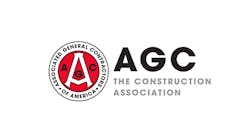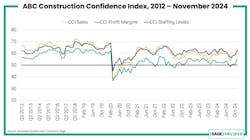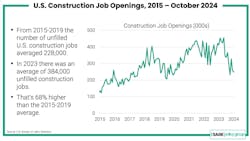Latest from Construction Data
Sponsored
As we head into 2025, it is with a greater sense of confidence than at the start of 2024.
Inflation seems under control, and interest rates are in decline. The economy appears to have enough momentum that most economists are not predicting a recession any time soon. Elections are over, providing some clarity on what economic policy and the regulatory environment will look like (for the next two years, at least).
But it is not all smooth sailing for the mechanical contracting industry. Finding enough skilled workers remains the top concern of most contracting companies—a problem made worse by the retirement of the Baby Boom generation. Geopolitical tensions remain high, affecting energy prices and some parts of the supply chain. The incoming administration has all but promised a trade war with some of the US’s largest trading partners.
And, looming behind everything, is the problem of massive debt—both public and private—that makes much of the spending fueling our economy unsustainable.
Let’s look at the current state of the US economy, and what we can expect in the coming year.
Where Things Stand
2024 saw the US economy grow by 4.2%, which compares favorably to world growth, which topped out at 3.2%. Q3 US GDP was 2.8%, with the Federal Reserve Bank of Atlanta estimating a Q4 GDP of 3.3%.
Most of that growth is coming from consumer spending, which for the past year has been mainly on services and goods (both durable and non-durable). However, fixed investment (which includes construction) has been down (see “Focus on Construction” below).
Much of that consumer spending is going on the credit card. In Q3 of 2024 total household debt increased by $147 billion to reach $17.94 trillion. Aggregate delinquency rates edged up from the previous quarter, with 3.5% of outstanding debt in some stage of delinquency. Mortgage balances rose by $75 billion from the previous quarter to reach $12.59 trillion at the end of September.
Interestingly, while US consumer optimism hit its highest level in Q4 since before the COVID-19 pandemic, consumers across income levels and generations said (according to a survey conducted by McKinsey & Co.) they plan to keep their spending habits relatively subdued in the coming year, particularly in discretionary and luxury categories.
(Of course, it remains to be seen if consumers will, in fact, reign in their spending habits.)
Dwarfing consumer debt is the US national debt, which currently stands at $36.15 trillion. As of November 2024, it costs $169 billion to service the debt, which will amount to 13% of the total federal spending in fiscal year 2025.
Inflation and Interest Rates
The current US inflation rate is 2.7% for the 12-month period ending in November 2024, up slightly from the 2.6% reported last month. The consumer price index (CPI), which measures changes in prices, increased 0.3%, a slight increase from the 0.2% recorded over the prior four months.
Although that 2.7% is above the Federal Reserve’s target 2% rate, the Fed has been cutting rates throughout 2024, reasoning (correctly) that an economy as large as the US’s doesn’t stop on a dime, but also (probably) remembering 2022, when they did not raise interest rates quickly enough in response the post-pandemic inflation spike.
At the December 2024 Federal Open Market Committee meeting (held December 19th), the Fed lowered interest rates by 25 basis points. This lowers the target interest rate range to 4.25% - 4.5%. It marks the third consecutive rate cut, following a 25-basis-point reduction in November and a more aggressive 50-basis-point reduction in September.
Despite the Fed’s efforts, however, inflation remains stubbornly high. Part of this is due to the very tight labor market (see “Workforce Concerns” below). Scarce labor puts pressure on wages, which in turn drives companies to increase prices. In October 2024 (when inflation was at 2.6%) wages grew by 4.6 percent. The inflation rate has not exceeded the rate of wage growth since January 2023. Building an economy with both high employment and stable prices is, necessarily, a difficult balancing act.
Focus on Construction
The construction market has seen a lot of disparity (thanks, in part, to infrastructure investment) with large contractors taking advantage of large projects, while smaller contractors in certain markets are seeing work dry up.
Associated Builders and Contractors reported December 10th that its Construction Backlog Indicator remained unchanged at 8.4 months in November of 2024, according to an ABC member survey conducted Nov. 20 to Dec. 3. The reading is down 0.1 months from November 2023.
ABC’s Construction Confidence Index readings for sales, profit margins and staffing levels improved in November. The readings for all three components remain above the threshold of 50, indicating expectations for growth over the next six months.
Workforce Concerns
The last time the US lost jobs was back in December of 2020—the economy has added jobs every month since and is still moving forward. As of November 2024, the unemployment rate stood at 4.2%.
Construction has added almost 700,000 jobs in the last five years. However, the post pandemic labor market appears to be softening (that is, job openings declining) even as wages continue to rise.
The Plumbing-Heating Cooling Contractors—National Association (PHCC) is cautiously optimistic about 2025. However, the skilled labor shortage continues to be a big challenge for the industry. In fact, it is projected that the plumbing-heating-cooling industry will need approximately 114,500 new trades people to meet the demand by 2028.
“As more young people today are looking at jobs that offer them greater flexibility, good wages, financial relief and quicker entry into the workforce, choosing an alternative career path like the skilled trades has become a viable option to the next generation,” said Daniel Quinonez, Executive Director for the PHCC Educational Foundation. “According to current market trends, many are choosing to forgo the traditional four-year degrees only to pursue vocational training programs instead. We’re seeing this shift through our PHCC Academy ® pre-apprentice and apprentice programs, which has seen a significant increase in enrollment over the last few years.”
Among the factors that Quinonez attributes the rise in enrollment for the Academy’s plumbing and HVAC trade courses to are job security, demand and financial incentives.
“Where else can you find stable employment with competitive wages and career advancement opportunities, regardless of how the economy is doing,” said Quinonez. “And with fewer people entering the trades while many are aging out, there continues to be a growing demand for skilled workers.”
Where Things are Going
One chief leading indicator for the economy is the Architectural Billings Index (ABI), a gauge of how much business leading architecture firms are seeing. For November 2024, the ABI was flat, with the share of firms that reported declining billings essentially the same as the share that reported increasing billings. This may reflect a “wait and see” approach on the part of some construction firms ahead of the US elections.
Based on current trend lines—including inflation, interest rates, confidence levels, etc.—most economists are predicting continued economic growth in 2025, although at a slightly lower rate than in 2024. In a recent webinar conducted for Construction Executive Magazine, Anirban Basu, Chief Economist for Associated Builders and Contractors said, “If I were an economic advisor to the Trump Administration, I would advise that they wait and do nothing. As interest rates continue to fall, it will spur construction, investment, homeownership and job growth.”
However, “wait and do nothing” looks like the incoming administration’s least likely course of action. Many businesses are eagerly anticipating lower taxes, and a more industry-friendly regulatory environment, and these may indeed find their way through Congress and ultimately work to boost economic growth.
However, the Trump team has promised two distinct sets of policies that have economists concerned.
The first is sweeping tariffs aimed at some of the US’s largest trading partners, including China, Canada and Mexico. While tariffs may give an advantage to some domestic businesses, in the short term they will almost certainly drive up costs for a range of imported goods, which would certainly spur inflation.
That said, it remains to be seen just how much of these proposed tariffs are genuine, and how much is posturing to secure an advantage in future economic and political negotiations. Time will tell.
The second is mass deportations of undocumented immigrants. Given the already tight labor market this would drive up the cost of labor, particularly in sectors such as agriculture and hospitality, which would also increase inflation. While the incoming administration seems in earnest about fulfilling on this promise, actually making it happen involves huge logistical challenges. Again, time will tell.
Importantly, it does not appear the new administration is serious about addressing the national debt. During the (at the time of this writing) President-Elect’s first term in office, laws and executive orders signed by him added roughly $8.4 trillion to the national debt over a 10-year period.
Other ongoing economic concerns include the war in Gaza, the war in Ukraine, possible economic instability in China, and the possibility of another pandemic (cases of H5N1 Bird Flu are rising, but do not appear to be spreading person-to-person).
While all of these many factors are worth keeping an eye on, the main focus for any contractor in the coming year should be their individual business and the markets that they serve. Well-managed companies can always find a way to thrive, even in the face of adverse economic conditions.
Steve Spaulding | Editor-inChief - CONTRACTOR
Steve Spaulding is Editor-in-Chief for CONTRACTOR Magazine. He has been with the magazine since 1996, and has contributed to Radiant Living, NATE Magazine, and other Endeavor Media properties.




